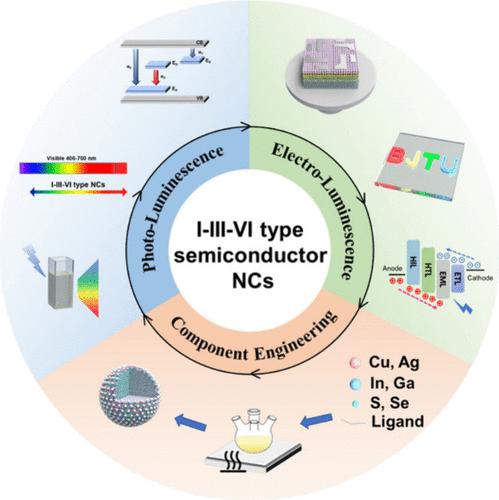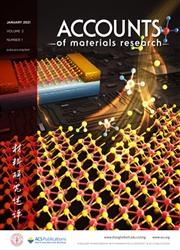Component Engineering in Multinary Alloyed I-III-VI Type Semiconductor Nanocrystals for Photoluminescence and Electroluminescence
IF 14
Q1 CHEMISTRY, MULTIDISCIPLINARY
引用次数: 0
Abstract
Display technologies have been developed in an unprecedented way in the past one hundred years. The evolution of display technologies is remarkable, progressing from the initial cathode ray tube and rear projection technology to the second-generation advancements of plasma and liquid crystal displays. Now, with the ongoing development of light-emitting diodes (LEDs) technology, including organic LEDs (OLEDs) and quantum dot LEDs (QD-LEDs), we are looking forward to a transition toward mini-LED, micro-LED, and nano-LED technologies. This evolution is gradually rendering displays thinner, more convenient, high-definition, highly luminous, and cost-effective. At present, commercially available OLEDs technology is afflicted with drawbacks such as intricate solution processing, difficulties in achieving efficient mass production, and suboptimal stability, limiting its widespread adoption. QD-LEDs serve as a perfect complement to the limitations of OLEDs and demonstrate a large potential for application in the next generation of displays. Quantum dots (QDs) are nanocrystals (NCs) with a size of 1–10 nm. Since the 1980s, researchers have studied and developed these magic tiny particles. At present, Cd-based materials have been extensively studied, resulting in red-, green-, and blue-LEDs devices approaching or surpassing theoretical external quantum efficiency limits. And the lifetime of Cd-based LEDs has reached commercial standards expected for blue-LEDs. However, the intrinsic toxicity of Cd element limits their further development. In the past decades, several Cd-free QDs have been developed and extensively researched, including III-V type InP QDs, perovskite QDs, I-III-VI type QDs, II-VI type ZnSe QDs, carbon dots, and so on. Among these Cd-free QDs, I-III-VI type semiconductor nanocrystals demonstrate remarkable potential due to facile synthesis, large tunable luminescence range, and solution processability. Moreover, owing to its distinctive nonstoichiometric composition, the luminescence peak position can be readily tuned from the blue to near-infrared by means of straightforward component engineering. This Account presents an overview of the I-III-VI type NCs, starting with the photoluminescent properties regulated by component engineering. Interestingly, narrow-band emission can also be realized through component engineering. Then the construction of light-emitting diodes based on these materials is discussed, encompassing wide-band and narrow-band emission. Additionally, interface engineering is adopted for balancing carrier injection to enhance electroluminescent properties. Moreover, taking advantage of the wide-band emission characteristics of I-III-VI type NCs, white LEDs with high color rendering index can be fabricated by incorporating other blue-emitting materials. Finally, the present challenges and prospective solutions are proposed to propel the advancement of I-III-VI type NCs with high expectations.

用于光致发光和电致发光的 I-III-VI 型二元合金半导体纳米晶体中的元件工程
在过去的一百年里,显示技术得到了前所未有的发展。显示技术的发展令人瞩目,从最初的阴极射线管和背投技术发展到第二代等离子和液晶显示器。现在,随着包括有机发光二极管(OLED)和量子点发光二极管(QD-LED)在内的发光二极管(LED)技术的不断发展,我们期待着向微型 LED、微 LED 和纳米 LED 技术过渡。这种演变将逐渐使显示器变得更薄、更方便、高清晰度、高亮度和高性价比。目前,市面上的有机发光二极管技术存在着溶液处理复杂、难以实现高效量产和稳定性不佳等缺点,限制了其广泛应用。量子点发光二极管(QD-LED)是对有机发光二极管局限性的完美补充,在下一代显示器中具有巨大的应用潜力。量子点 (QD) 是一种尺寸为 1-10 纳米的纳米晶体 (NC)。自 20 世纪 80 年代以来,研究人员一直在研究和开发这种神奇的微小颗粒。目前,镉基材料已得到广泛研究,其红光、绿光和蓝光 LED 器件已接近或超过理论外量子效率极限。镉基 LED 的使用寿命也达到了蓝光 LED 的预期商业标准。然而,镉元素的内在毒性限制了其进一步发展。在过去的几十年中,人们开发并广泛研究了多种无镉 QDs,包括 III-V 型 InP QDs、过氧化物 QDs、I-III-VI 型 QDs、II-VI 型 ZnSe QDs、碳点等。在这些无镉 QDs 中,I-III-VI 型半导体纳米晶体具有合成简便、发光范围可调且可溶液加工等特点,因而具有巨大的发展潜力。此外,由于其独特的非化学计量组成,通过简单的元件工程,发光峰的位置可以很容易地从蓝色调谐到近红外。本开户绑定手机领体验金概述了 I-III-VI 型 NC,首先介绍了通过成分工程学调节的光致发光特性。有趣的是,窄带发射也可以通过元件工程实现。然后讨论了基于这些材料的发光二极管的构造,包括宽带和窄带发射。此外,还采用了界面工程来平衡载流子注入,从而增强电致发光特性。此外,利用 I-III-VI 型 NC 的宽带发射特性,可通过加入其他蓝色发光材料制造出具有高显色指数的白光 LED。最后,提出了当前面临的挑战和未来的解决方案,以推动 I-III-VI 型 NCs 的发展,并对其寄予厚望。
本文章由计算机程序翻译,如有差异,请以英文原文为准。
求助全文
约1分钟内获得全文
求助全文

 求助内容:
求助内容: 应助结果提醒方式:
应助结果提醒方式:


